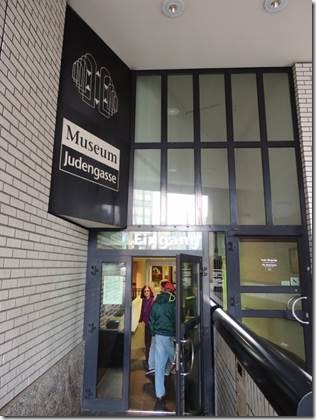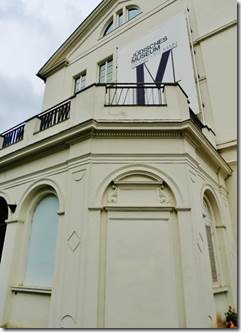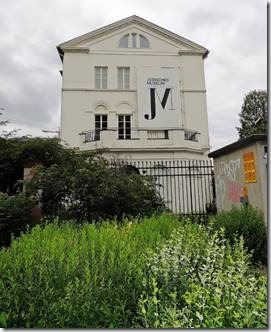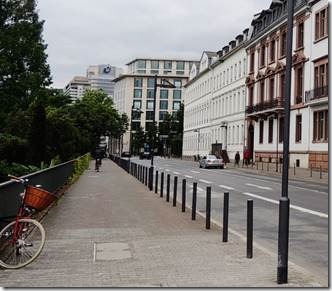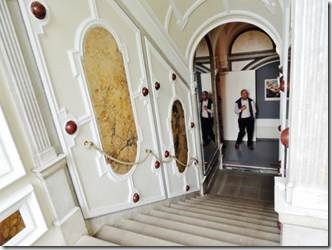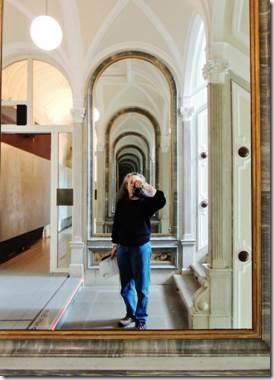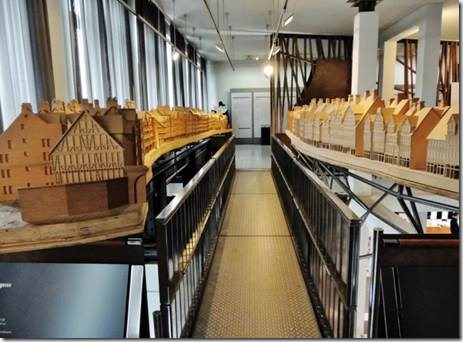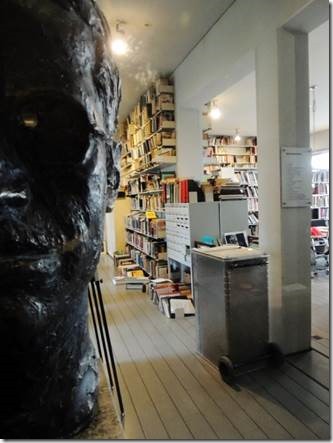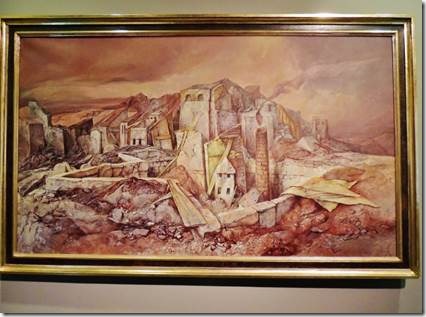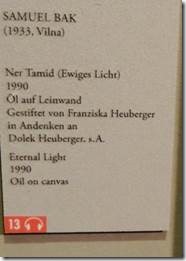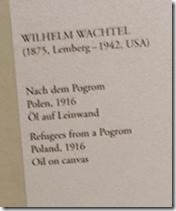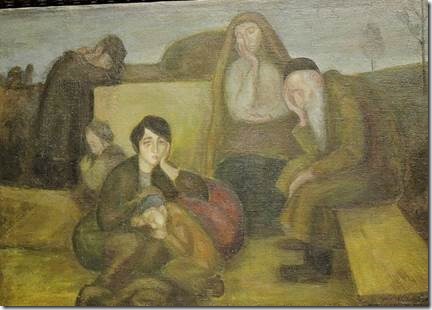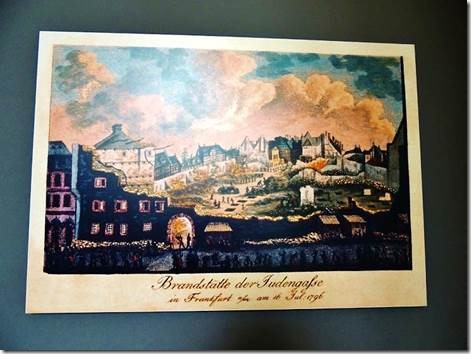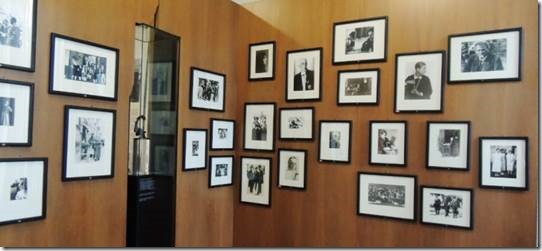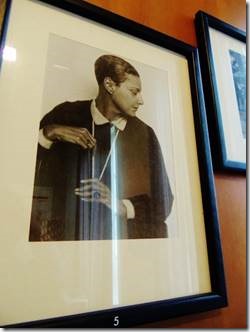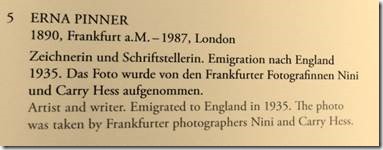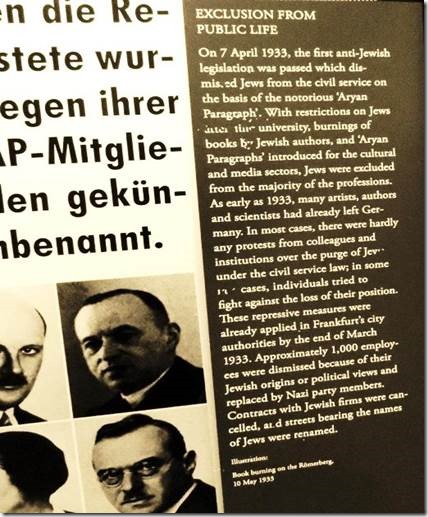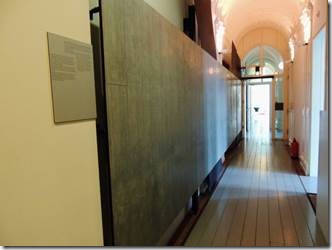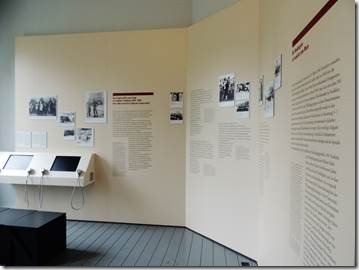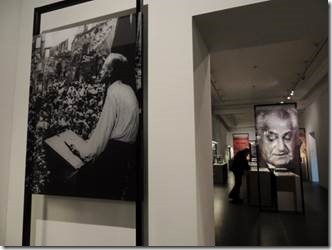On the Main after the Kitzigen Schleuse
Guten Morgen,
We’ve gone through 3 locks and have maybe 2, 3 or 4 to go depending on where we stop. We left Eibelstadt just past Wurzburg after a two night stop there. We were lucky to have found a spot at the Marina Levandowski because it was quite full and really built for smaller boats. We were the larges boat in the marina and the 2nd largest ever to have visited.
This email is the final one from our visit to Frankfurt. I toured the Jewish Museum during our second day.
Ru
Frankfurt Jewish Museum http://juedischesmuseum.de
“Jews have lived in Frankfurt continuously for nearly 900 years, longer than in any other German city. They worked as merchants, bankers, politicians, philanthropists, artists and scientists. In 1949, after the National Socialist devastation, the Jewish community was reestablished. It now has some 7,200 members, half of whom come from the former Soviet Union. Along with Berlin, Munich and Düsseldorf, Frankfurt is one of the four largest Jewish communities in Germany. Its many institutions include two kindergartens, the I. E. Lichtigfeld School in the Philanthropin, and the Senior Citizens’ Home, as well as a number of social services and programs for seniors. The community offers regular Liberal as well as Orthodox services. “ http://en.juedisches-frankfurt.de/
"Jewish History Must Not Be Reduced Merely to the Holocaust" – an Interview with Raphael Gross
http://www.goethe.de/ges/phi/red/jul/umg/en2625340.htm interview with the director of the Jewish Raphael Gross, Director of the Jewish Museum and Head of the Fritz Bauer Institute in Frankfurt as well as Director of the Leo Baeck Institute in London.
|
Museum Judengasse “The exhibition is centered around the fundaments of 5 houses, 2 ritual baths, 2 wells and a part of the sewerage system of the former Judengasse. The show documents the history of the street, its inhabitants and buildings of over 300 years. Historical illustrations, written documents, visual and audio materials convey a picture of the ghetto from the Jewish perspective as well as the view of the Christian world outside. A model with over 1,000 buildings gives an impression of the location of the Judengasse in the eastern part of the city. A database system can be used to get more detailed information on historical events like the “Fettmilch” revolt of 1614 or the burning of the Judengasse 1711, of religious institutions, the daily life and professions of the inhabitants or the development of the architecture.” I didn’t tour the Museum Judengasse but did visit the Judisches Museum. |
|
Judisches Museum The Jewish Museum is accommodated in a building ranked as an historical monument the classical Rothschild Palace and its adjacent building at Untermainkai 14/15. The building itself exemplifies the life style of the upper middle class Jewish family of the 19th century. In 1846 Mayer Carl von Rothschild purchased the building, which had been constructed in 1821, and enlarged. After his death, the palace accommodated the Freiherrich Carl von Rothschild’sche Offentliche Bibliothek, a public library founded by the Rothschild family. It was mid-afternoon but we were all pretty tired when we arrived at the museum. I stayed to visit. You could spend a day there but after a few hours I was exhausted so only saw bits. But I did purchase a book about both museums which explains about the exhibits I didn’t take time to see. |
|
“The stairway with mirrors and coloured marble incrustations in the Renaissance style …” Jewish Museum Frankfurt am Main book I had a handheld audio guide that told about some of the exhibits. And some of the explanatory material was in English. Unfortunately the video interviews with contemporary members of the Jewish community weren’t translated into English. But the museum is aimed at the German community to teach and remind. |
|
“At the same time as the Jews of Frankfurt were forced to move to the ghetto in the Judengasse, Jews were being driven out of most other southern German cities. The displaced either settled in rural areas or moved to Poland. Frankfurt was one of the few cities that did not expel its Jews. The influx of Jews to Frankfurt from around 1550 onwards led to a considerable increase in the population of the Judengasse, making it the largest Jewish community in Germany. ….A model of the Judengasse on a scale of 1:50 as it was after the great fire of 1711. During this time 3,000 people lived in its cramped and unhealthy conditions in a Ghetto originally intended to house just 100.” Jewish Museum booklet |
|
“The museum library is open to staff and visitors alike. It is a reference library with more than 20,000 volumes on the subject of Judaism and the history of the Jews in Germany and Central Europe as well as films…. The archive collects works by Jewish and exiled artists from the period 1933-45.” Jewish Museum book |
|
The history of Jewish in Germany is as emotional as historical. Sometimes the story is told better through art than words. The burned out Jewish homes are wrapped in the remains of a stone wall shaped as a Jewish Star. http://www.yadvashem.org/yv/en/exhibitions/bak/intro.asp has several pages about Bak as well as a biography including his family’s time in hiding and the nun who first encouraged his art work. Wilhelm Wachtel (Lvov 1875-1942 USA) Painter, engraver and illustrator. He studied at the Academy of Fine Arts in Cracow under Leopold Loeffler and Leon Wyczolkowski and then at the Academy of Fine Arts in Munich (under N.Gysis). He lived in Lvov but traveled to Vienna, Paris and Palestine: 1924, 1929, and 1932. He settled in Palestine in 1936. His works of art were presented at the Society of the Friends of Fine Arts in Lvov (1900), in Cracow. He has individual exhibitions in 1935 at the Zacheta Gallery in Warsaw. Initially he painted symbolic Jewish scenes, portraits, and landscapes, later in postimpressionistic style. http://www.farkash-gallery.com/91149/Wilhelm-Wachtel The Judengasse on fire, 14 July, 1796 Contemporary drawing Historisches Museum Frankfurt am Main. In the last third of the eighteenth century, the Jewish community and individual Jews wrote a number of letters to the Frankfurt city council and citizenry requesting an improvement of the living conditions in the Judengasse. They pointed out the poor hygiene and the difficulty of educating their children to become “useful citizens.” The council dismissed their requests. Military events brought unexpected change. In the night of 13 to 14 July 1796, Frankfurt was bombarded and conquered by French troops. The houses in the northern section of the Judengasse went up in flames. 140 houses were destroyed and 1,800 Jews made homeless. The fire put an end to the forced confinement in the Judengasse. The subsequent public debate about rebuilding the houses and establishing a Jewish ghetto clearly indicate that although a few had changed their views of Jews in the course of the Enlightenment, there was no general consensus in favor of changing the socio-political situation. Unlike the rest of Frankfurt’s citizens, the Jews welcomed the government installed by Napoleon, expecting it to enforce equal rights for all in accordance with the regulations prevailing in France. Instead of the anticipated introduction of equal rights, Karl Theodor von Dalberg, appointed governor of Frankfurt by Napoleon, passed a new ordinance with 151 sections, which meant that the Jews of Frankfurt were still subject to special regulations and had to pay 22,000 guilders a year for protection. While all the other groups in Frankfurt approved the new regulations, the Jews railed against their enforcement with hitherto unparalleled vehemence. In their ‘battle by pen’ they criticized the rivalry of craftsmen and merchants, the church’s fear that the foundation of the Christian state might be undermined, and the patrician classes’ interest in maintaining a social homogeneity based on lineage and wealth. At Napoleon’s intervention, the situation of the Jews did eventually improve. In 1810, Napoleon established the Grand Duchy of Frankfurt and demanded the introduction of the French Civil Code, including the equality of all citizens. After a long and difficult negotiations, a bill was passed at the end of 1811 recognizing the equality of Frankfurt’s ‘Schutzjuden’ (protected Jews) before the law. In 1812, the Frankfurt Jews were finally granted the equal rights fro which they had fought so land and at such great expense. But by 1814, with the end of the French occupation following the defeat of Napoleon, they were revoked…… in 1864, the Jews were finally granted equal rights in Frankfurt, followed in 1869/71 by the rest of the German Reich. A few administrative restrictions nevertheless remained in place, barring Jews from becoming military officers or professors, for example.” Jewish Museum book Life got better and life got worse… |
|
In 1925 there were 30,000 Jews living in Frankfurt. They accounted for 6.3% of the population. Their political leanings, cultural interests, occupations and religious views were so diverse and individual that it is not possible to make generalizations about Jews in the Weimar Republic.” Some whose photos are shown here : Social worker and feminist Bertha Pappenheim, an Orthodox woman; the German nationalist Arthur von Weinberg; the painter Jakob Nussbaum; a class of girls at the Orthodox Samson Raphael Hirsch School; Alwin Kronacher, who was an influential figure in the arts and culture of Frankfurt, and the fencer Helene Meyer, who won a gold medal for Germany in at the 1936 Olympics. I was particularly fascinated by this photo of Erna Pinner and photographers Nini and Carry Hess I listened to the audio presentations about Pinner and the Hess sisters (no photo of the Hess sisters) and had I time would have listened to all the stories which were fascinating and but mostly tragic. The artist and writer Erna Pinner died on 5 March in London aged 97. She was born in Frankfurt, the daughter of a well known surgeon. Lovis Corinth, a friend of Geheimrat Pinner, invited Erna. then 18, to study with him in Berlin. Between 1911 and 1914 she completed her studies at the Academic Ransson in Paris under Maurice Denis. At the outbreak of war she returned and began her systematic study of animals and animal behaviour at the Frankfurt Zoo. In 1917 her life-long friendship with the expressionist writer Kasimir Edschmid began. Erna Pinner entered the circle of young expressionists of the Darmstddter Sezession. Her studio became the meeting place of the group, including the poets Theodor Daubler and Else Lasker-Schuler,the writers Carlo Mierendorf and Rene Schickele, also the philosopher Theodor Adorno. In 192() she contracted polio, the after effects of which handicapped her for the rest of her life. Determination and self-discipline became the source of her courage and great energy. She survived the turmoil of the inflation years through the creation of near life-size puppets, often Portraits of her friends. Some of these famous creations are illustrated in Das Puppenbuch (The Book of Puppets) published in 1921 For the publisher Erich Reiss in Berlin she illustrated Das Blumenschiff (The Flower Boat) by Klabund in 1921 and her own picture book Das Schweinebuch (The Book of Pigs) in 1922. Particularly fruitful became her collaboration with the printer and typographer Pepy Wiirth of Darmstadt with whom she produced from 1923 onwards ten books in limited editions. During the 1920s and early ’30s Erna Pinner travelled with Edschmid around the world, to Africa and South America, Arabia, and several times to Greece, Spain and Italy. These years of travel and adventure are reflected in the books Edschmid and Pinner made together, richly illustrated with lithographs and etchings. Eine Dame in Griechenland (A Lady in Greece) 1927, and Ich reise um die Welt (I Travel Around the World) 1931, combine her lively texts with a wealth of illustrations. Here she developed a strong graphic style achieving the balance between naturalistic observation and linear abstraction which gave her work precision and atmosphere. Annual exhibitions of her work were held at the Flechtheim Gallery in Berlin and her articles and illustrations appeared in the magazines Die Dame and Der Querschnitt. This stream of creativity was interrupted by the Nazi persecution of the Jews. In 1935, Erna Pinner was able to settle in London. Her entire oeuvre which she had to leave behind was destroyed. At 45 she At 45 she started her second career. The Director of the London Zoo, Julian Huxley, who knew and admired her German work, helped her to get commissions to write and illustrate books on natural history. Meeting Henry Moore in 1936 gave her much needed artistic encouragement. Her drawings changed towards a more naturalistic style, the animal figures acquired more volume, detail and texture. Her wood cuts and lithographs of that period show the high degree of her artistic and technical abilities. Her collaboration with the zoologist G. M. Vevers and the ornithologist Ludwig Koch led her towards more scientific work based on her own observations of animals in the wild and in captivity. Two books summarizing that research were published by Jonathan Cape, London – in 1951, Curious Creatures and, in 1955, Born Alive. These works were again beautifully illustrated by Erna Pinner and translated into many languages. Together with her friends in exile, among others Richard Friedenthal, Gabriele Tergit and Elias Canetti, she joined the PEN Club of German authors in exile. With them she was one of the first to reach across to Germany after 1945. Her correspondence with Gottfried Benn at this time bears witness of her great humanity and understanding. Erna Pinner lived long enough to see the achievements of her generation reinstated and given a place of honour in German culture. In 1960 she received the Bundesverdienstkreuz. She still continued working and writing until she was 90. Only her last seven years she called her ‘retirement’. Her great age was a gift not only for herself but to her friends as well. http://www.ajr.org..uk/journalpdf/1987_may.pdf The Bundesverdienstkreuz (Federal Cross of Merit) is officially called the Verdienstorden der Bundesrepublik Deutschland (Order of Merit of the Federal Republic of Germany). It is Germany’s only general decoration. This Federal Order of Merit was created on 7 September 1951. Between 3,000 and 5,200 awards are given every year in all classes. http://simple.wikipedia.org/wiki/Bundesverdienstkreuz http://www..amazon.co.uk/ is the Erna Pinner page at Amazon “In the years between 1914 and 1933 numerous significant personalities in art, culture, politics, society and sport met in the photographic portraiture studio of Nini and Carry Hess. With their technical and aesthetic brilliance, the sisters were among the leading photographers in Germany of the time. In the 1920s their photographs essentially stamped the image of Woman. Their long collaboration with the Städtischen Bühnen Frankfurt (Frankfurt city theaters) resulted in the portraits of numerous actors, both in the roles they played and in their own person. These included Albert Bassermann (1867–1952), Elisabeth Bergner, Carl Ebert (1887–1980), Heinrich George (1893–1946), Paul Graetz (1890–1938), Gerda Müller (1895–1951), Leontine Sagan (1889–1974); the composers Paul Hindemith (1885–1963) and Leos Janacek (1854–1928), and the authors Thomas Mann (1875–1955), Fritz von Unruh (1885–1970) and Carl Zuckmayer (1896–1977)……… Like many of the artists working in the field of Frankfurt theater, Nini and Carry Hess were compelled to terminate their collaboration with the theaters in 1933. Carry’s attempt to develop a new professional life in Paris proved a failure. In the winter of 1938–1939, after the SA (the Nazi Sturmabteilung; Storm Troopers) destroyed the studio, including all its technical equipment and the archives of negatives on November 10, 1938, she fled to the South of France, where she survived the war in hiding. In 1942 Nini Hess was deported and murdered in Auschwitz. After World War II Carry Hess returned to Paris, but was unable to resume work because she was blind in one eye. In 1957 she received reparations and a pension from the authorities in Wiesbaden (Germany). She died in Chur on August 17, 1957, while on vacation in Switzerland. Only a few of the original photographs taken by Nini and Carry Hess survived the Nazi period in private collections, museums and archives. “ http://jwa.org/encyclopedia/article/hess-nini-and-carry-hess |
|
A “memorial” with the names of nearly 11,000 German Jewish citizens who have been deported from Frankfurt and murdered commemorates the fate of the Jews during the Holocaust. |
|
A display about survivors and displaced persons camps, many who later emmigrated to what would become Israel, the USA, England, Australia, Argentina… “As early as the end of April 1945, a municipal facility was set up in Frankfurt for Jewish survivors, and with the return of the last community rabbi from Theresienstady in July of the same year, a synagogue community was established. This community joined with the committee of Polish Jews set up by Eastern European refugees in Frankfurt, and in 1949 the Frankfurt Jewiish community that still exists today was founded.” Jewish Museum book |
|
Special temporary exhibit Fritz Bauer – Der Staatsanwalt 10. April – 07. September 2014 “Fritz Bauer was born 1903 in Stuttgart. He emigrated from Germany to Scandinavia in 1936 after having been forced to resign from his work as a jurist and interned in a concentration camp. In 1949, he returned to Germany to participate in building a democratic society. He was a pioneer in reforming penal law and the prisons system. He strove to enable young criminals to be resocialized, and he constantly reminded the judicial administration of its social responsibilities. In 1952, as district attorney in Brunswick, he defended the right of resistance against National Socialism. In 1959, after becoming Hessian State Attorney General, he had an essential part in the capture of Adolf Eichmann and set the stage for the Frankfurt Auschwitz Trial which took place 1963-1965. This trial evoked for the first time in Germany a wide public response and a readiness previously lacking to confront recent German history. In 1968, in the midst of preparations for a further trial of the desk murderers among the National Socialist judicial administration, the bureaucrat perpetrators responsible for euthanasia crimes, Fritz Bauer died. The trial never took place. The Fritz Bauer Institute is committed to the memory of Fritz Bauer, the democratic German legal reformer who initiated the Frankfurt Auschwitz Trial (1963–1965). Fritz Bauer considered the Auschwitz Trial a way for German society to use the legal system as an opportunity for self reflection, to "put ourselves on trial and to learn about the dangerous factors in our history." |

